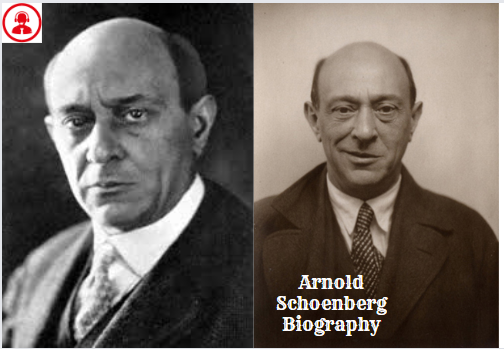Arnold Schoenberg Biography: Nationality, Parents, Age, Cause Of Death, Wife, Birthplace
Arnold Schoenberg Biography – Who is Arnold Schoenberg? Arnold Schoenberg, an influential figure in classical music, was both revered and controversial for his groundbreaking contributions to music theory and composition. This post looks into the details of his life, including his nationality, parents, age, cause of death, wife, and birthplace, providing a comprehensive look at the man behind some of the most revolutionary music of the 20th century.
Arnold Schoenberg Biography
| Detail | Information |
|---|---|
| Full Name | Arnold Schoenberg |
| Nationality | Austrian-American |
| Date of Birth | September 13, 1874 |
| Place of Birth | Leopoldstadt, Vienna, Austria |
| Parents | Samuel Schoenberg, Pauline Schoenberg |
| Wife | Mathilde Schoenberg |
| Age at Death | 76 years |
| Cause of Death | Illness |
| Date of Death | July 13, 1951 |
| Place of Death | Los Angeles, California, United States |
Arnold Schoenberg: A Revolutionary Composer
Arnold Schoenberg, born on September 13, 1874, in Leopoldstadt, Vienna, was a pioneering Austrian-American composer, music theorist, and teacher. His innovative approach to harmony and music theory significantly impacted the course of 20th-century classical music.
Early Life and Background
Schoenberg was born to Samuel and Pauline Schoenberg in the vibrant cultural milieu of Vienna. His early years were marked by a strong familial influence, though his parents’ death was tragic and mysterious, as they succumbed to a sickness that left them in a deep, prolonged sleep.
Musical Innovations
Schoenberg’s early works, such as “Verklärte Nacht” (1899), showcased his talent and laid the groundwork for his future innovations. He merged elements from Brahms and Wagner to develop a unique musical voice. His tenure as the mentor of Anton Webern and Alban Berg established him as a central figure in the Second Viennese School. This group was known for its atonal and expressionist music, which included works like Schoenberg’s “String Quartet No. 2” (1907–1908) and “Pierrot Lunaire” (1912).
Schoenberg’s concept of “developing variation” and “emancipation of dissonance” transformed traditional harmonic practices. His twelve-tone technique, which systematically interrelated all notes of the chromatic scale, was a groundbreaking development in music theory. This approach sought to bring unity to music that had previously relied on tonal centers.
Later Career and Emigration
In 1926, Schoenberg resigned from the Prussian Academy of Arts, and with the rise of the Nazis, he faced increasing hostility. The Nazis denounced his and his students’ music as “degenerate.” In response, Schoenberg emigrated to the United States in 1933. He continued to make significant contributions to music, teaching at the University of California, Los Angeles, from 1936 to 1944.
During his time in the US, Schoenberg explored various musical forms, including film music, and produced works such as his “Chamber Symphony No. 2” (1939). His composition “Ode to Napoleon” (1942), which satirized fascist regimes, reflected his response to the political turmoil of the time.
Final Years and Legacy
Schoenberg’s final years were marked by illness and a profound engagement with the aftermath of the Holocaust. He memorialized the victims in his work “A Survivor from Warsaw” (1947). Despite his declining health, Schoenberg remained active in the music community, receiving honorary citizenship from post-war Vienna and serving as an honorary president of the Israel Conservatory and Academy of Music in 1951.
Arnold Schoenberg’s legacy is profound. His pioneering methods reshaped the landscape of classical music and influenced subsequent generations of composers. His aesthetic and music-historical views have left a lasting impact on music theory and practice.
FAQs
Q: What was Arnold Schoenberg’s most significant contribution to music?
A: Schoenberg’s most significant contribution was his development of the twelve-tone technique, which transformed traditional harmonic practices and introduced a new approach to music composition.
Q: When and where did Arnold Schoenberg die?
A: Arnold Schoenberg died on July 13, 1951, in Los Angeles, California, United States.
Q: Who were Arnold Schoenberg’s parents?
A: Schoenberg’s parents were Samuel and Pauline Schoenberg. Their deaths were attributed to a mysterious illness that left them in a deep sleep.
Q: What was Schoenberg’s nationality?
A: Arnold Schoenberg was Austrian-American.
Q: How old was Arnold Schoenberg when he passed away?
A: Arnold Schoenberg was 76 years old at the time of his death.
Q: What was Schoenberg’s relationship with the Second Viennese School?
A: Schoenberg was a central figure in the Second Viennese School, mentoring key composers like Anton Webern and Alban Berg, and leading the movement in atonal and expressionist music.
Conclusion
Arnold Schoenberg’s life and work represent a pivotal chapter in the history of classical music. From his early innovations to his later explorations in the United States, Schoenberg’s contributions continue to resonate in contemporary music theory and practice. His legacy is a testament to his revolutionary spirit and enduring influence on the world of music

